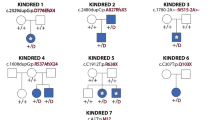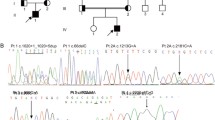Abstract
Mutations in the human gene TCOF1 cause a mandibulofacial dysostosis known as Treacher Collins syndrome (TCS). An infant rhesus macaque (Macaca mulatta) that displayed the TCS phenotype was identified at the California National Primate Research Center. The TCOF1 coding region was cloned from a normal rhesus macaque and sequenced. The rhesus macaque homolog of TCOF1 is 91.6% identical in cDNA sequence and 93.8% identical in translated protein sequence compared to human TCOF1. Sequencing of TCOF1 in the TCS-affected rhesus macaque showed no mutations within the coding region or splice sites; however, real-time quantitative PCR showed an 87% reduction of spleen TCOF1 mRNA level in the TCS affected macaque when compared with normal macaque spleen.




Similar content being viewed by others
References
Dixon MJ (1995) Treacher Collins syndrome. J Med Genet 32: 806–808
Dixon J, Dixon MJ (2004) Genetic background has a major effect on the penetrance and severity of craniofacial defects in mice heterozygous for the gene encoding the nucleolar protein treacle. Dev Dyn 229: 907–914
Dixon J, Hovanes K, Shiang R, Dixon MJ (1997a) Sequence analysis, identification of evolutionary conserved motifs and expression analysis of murine tcof1 provide further evidence for a potential function for the gene and its human homologue, TCOF1. Hum Mol Genet 6: 727–737
Dixon J, Edwards SJ, Anderson I, Brass A, Scambler PJ, et al. (1997b) Identification of the complete coding sequence and genomic organization of the Treacher Collins syndrome gene. Genome Res 7: 223–234
Dixon J, Brakebusch C, Fassler R, Dixon MJ (2000) Increased levels of apoptosis in the prefusion neural folds underlie the craniofacial disorder, Treacher Collins syndrome. Hum Mol Genet 9: 1473–1480
Dixon J, Ellis I, Bottani A, Temple K, Dixon MJ (2004) Identification of mutations in TCOF1: use of molecular analysis in the pre- and postnatal diagnosis of Treacher Collins syndrome. Am J Med Genet A 127A: 244–248
Edwards SJ, Gladwin AJ, Dixon MJ (1997) The mutational spectrum in Treacher Collins syndrome reveals a predominance of mutations that create a premature-termination codon. Am J Hum Genet 60: 515–524
Frischmeyer PA, Dietz HC (1999) Nonsense-mediated decay in health and disease. Hum Mol Genet 8: 1893–1900
Gladwin AJ, Dixon J, Loftus SK, Edwards S, Wasmuth JJ, et al. (1996) Treacher Collins syndrome may result from insertions, deletions or splicing mutations, which introduce a termination codon into the gene. Hum Mol Genet 5: 1533–1538
Haworth KE, Islam I, Breen M, Putt W, Makrinou E, et al. (2001) Canine TCOF1; cloning, chromosome assignment and genetic analysis in dogs with different head types. Mamm Genome 12: 622–629
Hayano T, Yanagida M, Yamauchi Y, Shinkawa T, Isobe T, et al. (2003) Proteomic analysis of human Nop56p-associated pre-ribosomal ribonucleoprotein complexes. J Biol Chem 278: 34309–34319
Horiuchi K, Ariga T, Fujioka H, Kawashima K, Yamamoto Y, et al. (2004) Treacher Collins syndrome with craniosynostosis, choanal atresia, and esophageal regurgitation caused by a novel nonsense mutation in TCOF1. Am J Med Genet A 128: 173–175
Horiuchi K, Ariga T, Fujioka H, Kawashima K, Yamamoto Y, et al. (2005) Mutational analysis of the TCOF1 gene in 11 Japanese patients with Treacher Collins syndrome and mechanism of mutagenesis. Am J Med Genet A 134: 363–367
Isaac C, Marsh KL, Paznekas WA, Dixon J, Dixon MJ, et al. (2000) Characterization of the nucleolar gene product, treacle, in Treacher Collins syndrome. Mol Biol Cell 11: 3061–3071
Jones NC, Farlie PG, Minichielle J, Newgreen DF (1999) Detection of an appropriate kinase activity in branchial arches I and II that coincides with peak expression of the Treacher Collins syndrome gene product, treacle. Hum Mol Genet 7: 2239–2245
Marsh KL, Dixon J, Dixon MJ (1998) Mutations in the Treacher Collins syndrome gene lead to mislocalization of the nucleolar protein treacle. Hum Mol Genet 7: 1795–1800
Marszalek B, Wojcicki P, Kobus K, Trzeciak WH (2002) Clinical features, treatment and genetic background of Treacher Collins syndrome. J Appl Genet 43: 223–233
Marszalek B, Wisniewski SA, Wojcicki P, Kobus K, Trzeciak WH (2003) Novel mutation in the 5′ splice site of exon 4 of the TCOF1 gene in the patient with Treacher Collins syndrome. Am J Med Genet A 123: 169–171
Paznekas WA, Zhang N, Gridley T, Jabs EW (1997) Mouse TCOF1 is expressed widely, has motifs conserved in nucleolar phosphoproteins, and maps to chromosome 18. Biochem Biophys Res Commun 238: 1–6
Rae TC (2004) Miocene hominoid craniofacial morphology and the emergence of great apes. Ann Anat 186: 417–421
Rae TC, Koppe T, Spoor F, Benefit B, McCrossin M (2002) Ancestral loss of the maxillary sinus in Old World monkeys and independent acquisition in Macaca. Am J Phys Anthropol 117: 293–296
Ross CF, Henneberg M, Ravosa MJ, Richard S (2004) Curvilinear, geometric and phylogenetic modeling of basicranial flexion: is it adaptive, is it constrained? J Hum Evol 46: 185–213
So RB, Gonzalez B, Henning D, Dixon J, Dixon MJ, et al. (2004) Another face of the Treacher Collins syndrome (TCOF1) gene: identification of additional exons. Gene 328: 49–57
Splendore A, Silva EO, Alonso LG, Richieri–Costa A, Alonso N, et al. (2000) High mutation detection rate in TCOF1 among Treacher Collins syndrome patients reveals clustering of mutations and 16 novel pathogenic changes. Hum Mutat 16: 315–322
Splendore A, Fanganiello RD, Masotti C, Morganti LS, Passos–Bueno MR (2005) TCOF1 mutation database: Novel mutation in the alternatively spliced exon 6A and update in mutation nomenclature. Hum Mutat 25: 429–434
The Treacher Collins Syndrome Collaborative Group (1996) Positional cloning of a gene involved in the pathogenesis of Treacher Collins syndrome. Nat Genet 12: 130–136
Valdez BC, Henning D, So RB, Dixon J, Dixon MJ (2004) The Treacher Collins syndrome (TCOF1) gene product is involved in ribosomal DNA gene transcription by interacting with upstream binding factor. Proc Natl Acad Sci USA 101: 10709–10714
Winokur ST, Shiang R (1998) The Treacher Collins syndrome (TCOF1) gene product, treacle, is targeted to the nucleolus by signals in its C-terminus. Hum Mol Genet 7: 1947–1952
Wise CA, Chiang LC, Paznekas WA, Sharma M, Musy MM, et al. (1997) TCOF1 gene encodes a putative nucleolar phosphoprotein that exhibits mutations in Treacher Collins syndrome throughout its coding region. Proc Natl Acad Sci USA 94: 3110–3115
Acknowledgments
The authors thank Marc Busch, Cindy Heisey, and Julie Heiner for their technical assistance and Wilhelm vonMorganland for his monkey photographs. AGH is supported by the California National Primate Research Center Base Operating Grant, NIH/NCRR grant RR00169. GZ was supported by grant EEC0234104 from the NSF/NIH Bioinformatics and Bioengineering Summer Institute program. RS was supported by NIDCR grant 1-RO1-DE13172.
Author information
Authors and Affiliations
Corresponding author
Additional information
Nucleotide sequence data reported are available in the DDBJ/EMBL/GenBank databases under the accession numbers DQ085095 and DQ085096.
Rights and permissions
About this article
Cite this article
Shows, K.H., Ward, C., Summers, L. et al. Reduced TCOF1 mRNA level in a rhesus macaque with Treacher Collins-like syndrome: further evidence for haploinsufficiency of treacle as the cause of disease. Mamm Genome 17, 168–177 (2006). https://doi.org/10.1007/s00335-005-0079-y
Received:
Accepted:
Published:
Issue Date:
DOI: https://doi.org/10.1007/s00335-005-0079-y




